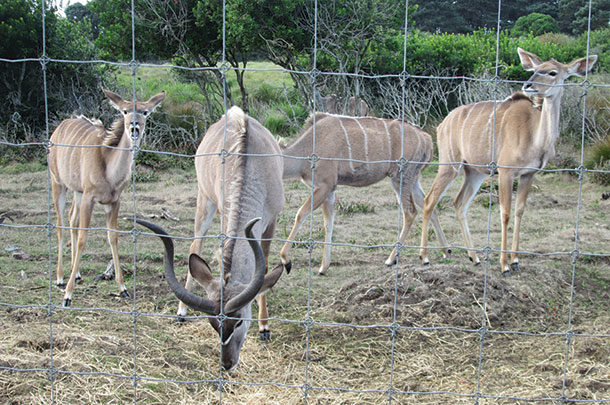There are people in this world who save their money so that someday they can travel to Africa to go on safari. Well, Africa might be closer than you know, and a safari can be had for a trip to B. Bryan Preserve at Point Arena in Mendocino County, California. Years ago when Frank Mello, a retired biochemist, was traveling through Texas to visit friends, he came across an African preserve where sable antelope were being raised . . . and he became hooked.
Since that time in 1998, he and his wife, Judy, have expanded their own preserve to include three types of antelope, three varieties of zebra, and the Rothschild giraffe – all native to Africa. Within the next five years they are also planning on bringing in black rhino, Cape buffalo and black wildebeest.

While a collection of animals like this makes a safari experience more likely for people living on the West Coast, it can also become a challenge to feed animals that normally exist on forage grasses native to Africa.
So what do they feed their animals? Alfalfa – the same type frequently fed to other commonly found breeding hoof-stock animals across the U.S., purchased in Oregon and shipped in by truckloads.
“We feed alfalfa because I can’t get anything else that provides the nutrients they need,” Mello says. “Our animals prefer it. We buy it by the truckload and bring it in from Oregon. A lot of truckloads…”
Mello says that their preserve is a breeding center focused on only African animals, many of which when found in their natural environment are in the southern coastal areas of Africa.
Their preserve is also in a coastal area in California and they go to great lengths to try to keep the menu items as similar to that found in the animals’ native habitats. While alfalfa isn’t usually on the menu in rural Africa, it’s the closest nutritional forage he can get.
Jean Simpson is the head animal trainer and owner of a place called the Wild Bunch Ranch where a large collection of North American animals are trained for use in movies. They also use alfalfa in the diet of their hoof stock – wild burros, donkeys, horses and bison.
“We aren’t a breeding facility, but if it is very cold, like below 10 degrees, we will use alfalfa as part of our feed,” Simpson says.
Simpson says they try very hard to maintain their animals on a diet similar to that they would be eating in the wild.

“We are trying to stay within their natural feed and it isn’t really healthy to have all of the extra protein,” Simpson says. “Grass is their usual feed.”
Ellen Dierenfeld has a unique job as an animal nutritionist with a background in animal science, fisheries and wildlife management. She travels all over the world and acts as a consultant to many different types of businesses dealing with animals – feed companies, zoos, wildlife conservation centers, as well as private individuals.
It’s a diverse clientele she serves and these aren’t the usual animals commonly found on the average farm. They range on the smaller end from rodents and primates, reptiles, snails, rabbits and guinea pigs to some of the larger animals that most might think of – giraffe, elephants, bison or antelope.
“We certainly use some alfalfa in zoos as we have several animal species that just don’t thrive on grass, Dierenfeld says. “We have to look at the nutrient composition of what these animals would normally eat in the wild; however, with some of them we can only guess.”
Her diversified background across multiple species has given her a good education as some of the best feeds are sometimes an extrapolation given the lack of information on some species kept in containment.
Alfalfa has a closer nutrient profile to some of the forages eaten by browsers, more so than grazers where grasses suffice, and often blends of alfalfa and grass work well for selective foragers.
In some cases however, alfalfa has been found to be an excellent replacement forage from a nutritional standpoint, such as when replacing tree leaves consumed in nature by giraffe and okapi (a relative of the giraffe).
Dierenfeld points out that animals being raised in zoos don’t have the same high production needs as dairy cattle, or even the higher energy needs like animals on a preserve, but they still need the high fiber that their normal forages would contain. Consequently, alfalfa remains an excellent feed choice.
“When I first started in the zoo community, many of the hoof stock were fed alfalfa as the sole forage. In many cases, however, alfalfa was just too rich – with the okapi and giraffe as the notable exceptions,” Dierenfeld says. “Some health issues from too-high-quality diets were identified. More frequently we now mix it with grass hay for many hoof stock."
"For example, deer and antelope species are mixed feeders; blending high-quality alfalfa with grass allows them to exhibit natural and selective foraging behaviors to better address their as-yet-unknown (in some cases) nutrient requirements.”
Dierenfeld says that as with any good feeding program, all of their alfalfa is laboratory tested to ensure quality.
“Similar to all natural products, growing, handling, and storage conditions influence nutritional content. You can certainly find alfalfa that is poorer-quality than grass hay,” she says. “Our purchase contracts are based on nutritional value specifications.”
Dierenfeld says they use alfalfa in leaf hay as well as cubes and pellets for various species and purposes. She says, “We use it for treats for higher nutrient management options – for example during growth or lactation periods, and sometimes as a training reward to make the animal easier to handle. Even some rodent, primate and reptile diets contain alfalfa and alfalfa meal is used as an ingredient in many manufactured diets fed to exotic herbivores.”
While most pet animals don’t require the high concentration of nutrients found in alfalfa that can cause health issues, alfalfa is advantageous to use during reproductive and rapid growth periods when some animals will do better due to the extra nutrition from protein, minerals and vitamins.
Alfalfa really isn’t just for cattle anymore. “Even snails need higher-calcium diets to build shells,” Dierenfeld says. “Alfalfa can be a good ingredient choice to provide that calcium.” FG
Becky Cook is a freelance writer based in Idaho.
PHOTOS: The B. Bryan Preserve in Mendocino County, California, uses alfalfa for many of their exotic animal diets, including giraffes, kudus and zebras. Photos by FG staff.













